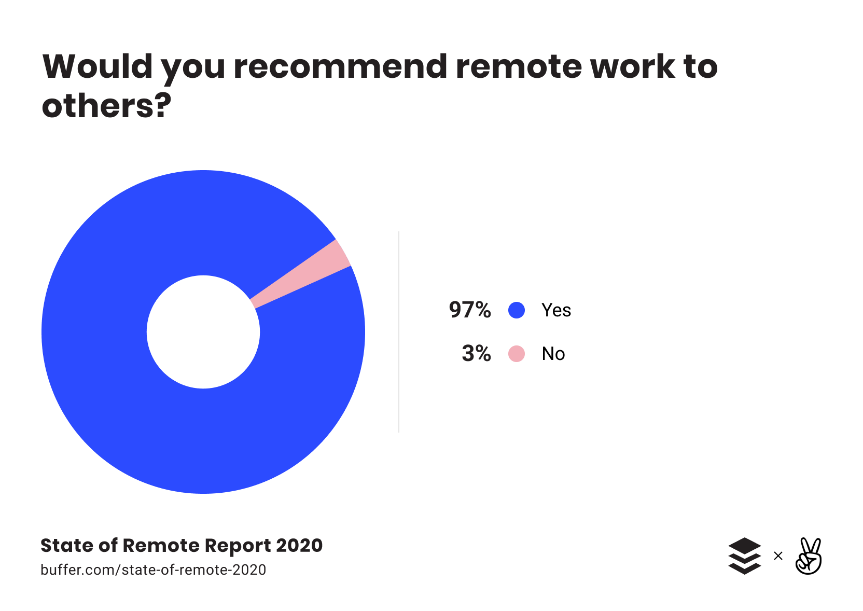Insight Paper September 4, 2020
The Future of Remote Work
Is it a passing trend or a new way to work?
How productive and effective can an employee be when working from the comfort of their home under no supervision? Looking back a decade ago, employers wouldn’t have even considered it, but today you might actually respond that they could be very productive, and even potentially more effective than if in an office. So, what has changed? Telework and teleconferencing technologies have advanced to the point that remote teams can continue to be productive and thrive in a remote setting. These days, the necessity of remote work is clear, but does it actually have longevity in the business world?
REMOTE WORK IN 2020 AND BEYOND
In studies completed by Gallup, Harvard University, Global Workplace Analytics, and Stanford University, researchers found that providing workplace flexibility will increase productivity, performance, engagement, retention, and profitability. They ultimately believe that these five categories will lead companies to an increased net income. But how? The study found that teleworkers are 35-40% more productive than their in-office colleagues. Additionally, it found by eliminating things like commuting expenses made companies an average 21% higher profitability. With the rise in the use of telecommuting, the opportunity to work-from-home has become a flashy employee benefit and an opportunity for companies to retain their employees. Zapier.com reports that 74% of the workforce would quit their job for one that offers remote opportunities. According to GlobalWorkplaceAnalytics.com data, telecommuting in the US has increased by 115% in the past decade. Remote work is showing no signs of slowing up and there is no better time than now for your company to get on board.

HOW DOES YOUR COMPANY NOT ONLY CAPITALIZE ON THE TREND BUT ALSO ENSURE LONGEVITY?
1. Create a digital office space
While in the office, person-to-person interactions happen all day organically. When a colleague has a question, they will walk to your desk and ask you. By creating a digital office space, it allows colleagues to continue these conversations, allowing quick access to each other. Products like Microsoft Teams and Slack are great tools for your company to communicate internally and keep your team feeling connected. While it’s important to maintain your professional work culture when moving to remote work, it’s also important to maintain a ‘fun’ culture. These user-friendly products allow the user to create threads or channels. These conversations can be created easily to discuss work or to allow employees to converse in a more relaxed setting. This creates a happy working environment.
2. Maintain connections with video conferencing
Humans by nature are social beings that learn and develop from face-to-face interaction. Teleconferencing has changed our ability to work remotely allowing us to continue face-to-face interactions from afar. Products like Zoom, WebEx, or Microsoft Teams, built in video conferencing feature, make it easy to host meetings and conference calls, which helps to build a collaborative environment that inspires and energizes employees to participate. This collaborative environment encourages engagement and thought sharing, which is important for company culture and growth.
While teleconferencing is a great way to engage internally with your teams, it’s also a great way to continue meeting and engaging with clients. For those in the client service industry, that spend most of their days working side by side with their clients, know the importance of face time and building trusted working relationships. Teleconferencing enables remote workers to continue these face-to-face interactions and socializing, which set the foundation for trust and better working relationships with clients.
3. Identify remote work policies and implement training programs
A key component of your company’s success when creating longevity with a remote setting is ensuring your employees are informed and properly trained on how to use these tools in their new setting. Identifying policies on how your digital workplace should be used and training on how to optimize those tools in your employee’s day to day lives will lead to continued success. Additionally, it’s important to understand that all clients are different, and these policies and tools may change over time. Being flexible to meet a variety of client demands and being able to change and adapt will only improve your ability to respond to a dynamic workforce.
While technology and opportunities will continue to change as the new decade progresses, remote work is here to stay. We’ve learned that workplace flexibility will increase productivity, performance, engagement, retention, and profitability, there is no better time than now to make remote work a top priority for your company.

